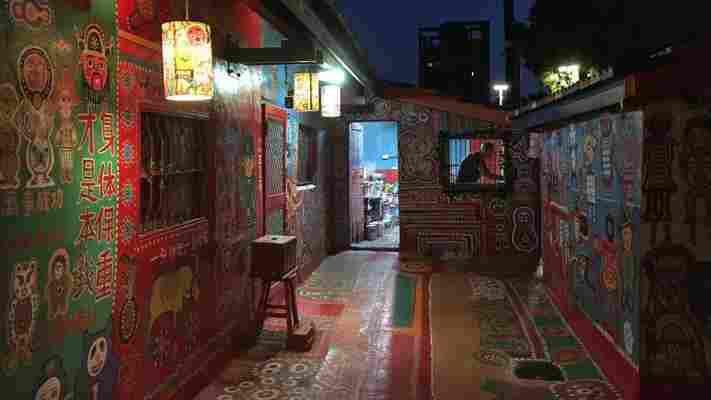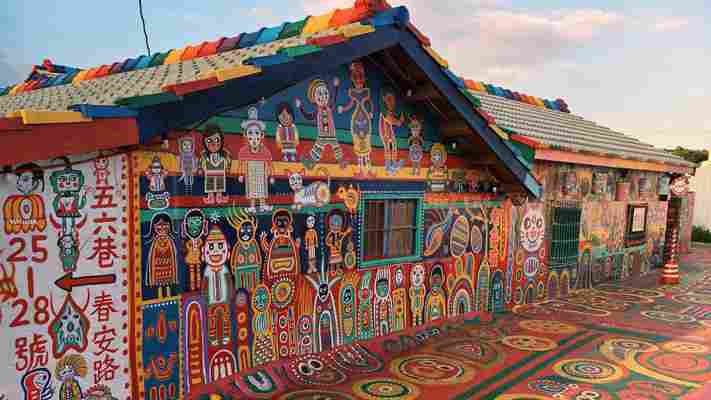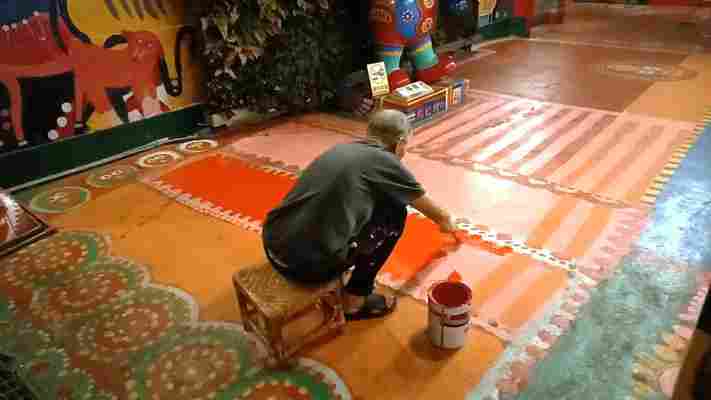

Every morning, Huang Yung-fu paints Rainbow Village (Credit: Eliot Stein)
It’s 04:00 in central Taiwan and everything is black. The city of Taichung’s 2.8 million residents are asleep, its flashing neon signs are off and the only movement cutting through the night is the silhouette of a 96-year-old man slowly painting alone in the darkness.
Every morning, Huang Yung-fu flips on a light, shuffles out of his two-room bungalow in sandals and carries a handful of paint tins into the streets outside. While the city around him sleeps, Huang crouches on a stool for three hours and quietly decorates the drab cement walls, pavement and windows with an explosion of playful murals in kaleidoscopic colours.
What began years ago with a single hand-painted bird on Huang’s bedroom wall has since grown into tens of thousands of illustrations. Today, this whimsical world of cartoon-like people, abstract animals and surrealist art is splashed across every centimetre of concrete in this former military settlement – called Rainbow Village . And now, more than one million visitors flock to the village every year to meet its elderly artist and lone permanent resident, affectionately known as ‘Grandpa Rainbow’.

In Rainbow Village, painted animals leap from the walls and peek out from doorways (Credit: Eliot Stein)
It’s hard not to smile when wandering the village’s paint-splattered streets. Tiny tigers leap from the walls, whiskered kittens hide in alleyways and a cheery parade of wide-eyed pandas, peacocks and people peek out from the doorways. Stay long enough and you may stumble upon dancing samurais, floating astronauts and kissing sweethearts.
While covering every corner of the village in a vivid dreamscape may seem like Huang’s life work, the self-taught artist only picked up a brush 10 years ago at the ripe age of 86. Not only has he transformed his Taiwanese settlement into a real-life storybook, but he saved it from demolition in the process.
“Ten years ago, the government threatened to knock this village down,” Huang said, daubing red lines on a walkway as crickets chirped through the dark. “But I didn’t want to move. This is the only real home I’ve ever known in Taiwan, so I started painting.”
Huang Yung-fu remembers drawing with his father at age five (Credit: Eliot Stein)
Huang was born outside Guangzhou, China, and remembers drawing with his father at age five. In 1937, he left home as a 15-year-old boy to fight the Japanese in the Second Sino-Japanese War . After World War Two, Huang joined the fight against Mao Zedong’s Communist government as the Chinese Civil War raged on back home. But when the Nationalist Party was defeated in 1949 and Zedong created the People’s Republic of China , Huang and two million other troops and their families followed its Nationalist leader, Chiang Kai-shek, as he fled to Taiwan.
To accommodate this influx of refugees, retreating military families were housed in hundreds of ‘ military dependents’ villages ’ throughout the island. These hastily built dwellings were meant to be a makeshift place for soldiers to lay low until the Nationalists could retake the mainland. That time never came, and over the years, these temporary dwellings became permanent.
After being stationed at various Taiwanese airbases, Huang was shot twice and critically wounded during the Second Taiwan Straits Crisis . When he finally retired from the military in 1978 with a gold medal for ‘Defending Taiwan’, he gathered his savings and moved into a bungalow in the village where he’s lived happily for the past 40 years. Today, visitors can find his door by looking for the illustration of a smiling soldier holding a paintbrush.
Huang Yung-fu's paintings spill outside and onto the village’s abandoned buildings (Credit: Rainbow Village)
As the Nationalists’ dreams of recapturing mainland China faded over the decades, many military dependents abandoned their homes, and the poorly constructed dwellings that remained began to deteriorate. As a result, the Taiwanese government began an aggressive campaign to demolish the crumbling settlements in the 1980s and ‘90s, and used the prime urban real estate to build high-rise condominiums. Today, only 30 of the original 879 military villages remain.
“When I came here, the village had 1,200 households and we’d all sit and talk like one big family,” Huang said, looking out of his bungalow window. “But then everyone moved away or passed away and I became lonely.”
By 2008, developers had snatched up all but 11 of the settlement’s original 1,200 homes and Huang slowly saw his friends leave one by one. Unmarried and with no family in Taiwan, Huang had nowhere to go. So, he remained until he was the last resident left. When he received a letter from the government that summer ordering him to vacate the village, the soldier did something he hadn’t done since he was a schoolboy: he picked up a paintbrush. First came the little bird in his bungalow. Then some cats, people and aeroplanes. Soon, his colourful creations began to spill outside and onto the village’s abandoned buildings and streets.
Rainbow Village is preserved as a public park (Credit: Eliot Stein)
One night in 2010 as Huang toiled away under the moonlight, a student from nearby Ling Tung University stumbled upon the ageing artist and learned of his solitary battle to stave off the government’s bulldozers one brush stroke at a time. After snapping a few images of Huang’s concrete canvas, the student started a fundraising campaign to purchase as much paint for Huang as possible and launched a petition to protest the settlement’s demolition.
“People were amazed at this artist’s passion and touched by students trying to help an old man,” said Andrea Yi-Shan Yang, chief secretary of Taichung’s Cultural Affairs Bureau. “As news of ‘Grandpa Rainbow’ spread, it soon became a national issue. He had our entire society’s attention and compassion.”
Within several months, Taichung’s mayor was inundated by 80,000 emails from citizens urging him to preserve the settlement. Against all odds, it worked, and in October 2010, Taichung’s mayor ordered the remaining 11 buildings, streets and surrounding areas to be preserved as a public park .
Grandpa Rainbow's paintings now cover an entire village (Credit: Eliot Stein)
It touches people’s hearts looking at this man’s work and hearing his story. It wasn’t a violent protest. He wasn’t asking for any help. He just loved his home,” Yang said.
Huang Yung-fu continues to wake up well before dawn and paint (Credit: Eliot Stein)
Since saving his small settlement, Huang continues to wake up well before dawn, grab his paintbrush and report for ‘duty’ – a habit he’s kept from his strict early-morning military days. “There are many things that I can’t do anymore, but I can still paint,” Huang said. “It keeps me healthy, and adding a little colour can turn something old into something beautiful.”
It also keeps him young. In fact, all of Huang’s art is inspired by his childhood memories and imagination, and there’s something poetic about a lifelong soldier who hadn’t picked up a brush in more than 70 years painting the puppy he loved as a boy, his favourite teachers and scenes of him and his younger brothers playing together in the Chinese countryside.
“People who come here sometimes compare his art to Spanish painter Joan Miró or Japanese animator and film director Hayao Miyazaki,” said Lin Young Kai, a staff member at Rainbow Village who helps Huang. “He just paints what he feels and what he remembers.”
In 2016, more than 1.25 million people visited Rainbow Village (Credit: Eliot Stein)
As images of Huang’s rainbow-hued hamlet have spread, the number of camera-toting visitors to the free park has grown. According to city officials, in 2016 more than 1.25 million people filed into Rainbow Village’s narrow, pedestrian-only alleyways. Huang usually goes outside to greet his guests in a buttoned-up collared shirt and flat cap, his hands often stained with flecks of paint from his early morning work.
For much of the past 10 years, Huang relied on coins left in a donation box outside his bungalow to buy his paint. Now, Lin and a group of young people help him sell postcards and illustrations of his work. Whatever proceeds don’t go towards his art are donated to local organisations that help the elderly. And whenever the mass of visitors to his village gets too much, he’ll sneak back inside his bungalow or over to a nearby stream to close his eyes and listen to the burbling water.
For years, Huang Yung-fu relied on donations to buy his paint (Credit: Eliot Stein)
It’s inspiring – not just Grandpa Rainbow’s story but his paintings. A lot of young people create art in the streets, but nothing like this,” said Esther Yu-Hsi, a visitor from Taipei.
Rainbow Village’s population has doubled since Huang Yung-fu got married (Credit: Eliot Stein)
In recent years, Huang’s health has deteriorated significantly and he’s spent a fair amount of time in the intensive care unit. ‘Sometimes it’s my heart, sometimes it’s my lungs,” he said, resting by a fan in his bungalow. “I guess I’m just getting old.”
Despite his nickname, ‘Grandpa’ has no children of his own. He had never married and figured he’d live out his days alone in his solitary settlement. But in 2013, Huang found love in the last place he ever expected: the hospital. During a dangerous bout of pneumonia, Huang fell in love with an elderly nurse tending to him and married her soon after. Now Rainbow Village’s population has doubled and ‘Grandma Rainbow’ shares Huang’s paint-crammed bungalow and the whimsical world he created outside most days of the week.
“Ever since I met her, only my lungs hurt,” Huang smiled. “My heart is better.”
Travellers pose for pictures with the artist in residence, Grandpa Rainbow (Credit: Eliot Stein)
After a long nap, Huang slowly shuffles back out of his bungalow and into the late afternoon heat to meet newly arrived visitors in his village. As travellers pose for pictures with the artist in residence, Grandpa Rainbow flashes the military ‘V’ for ‘victory’ sign before asking guests to please come back and visit him again soon.
No-one is sure how much longer Huang will be able to paint or what might happen to the colourful community he created after he's gone. There are talks of one day expanding Rainbow Village into an arts school for children or turning Huang’s bungalow into a museum. But at 96, Huang is taking things one day at a time.
“If I can get up and paint tomorrow, I will,” he said, sitting back in his chair and watching the crowds pass. “If I can’t, I will feel good knowing that this place will stay and make others happy.”
Custom Made is a BBC Travel series that introduces you to custodians of cultural traditions all around the world.
Leave a Comment